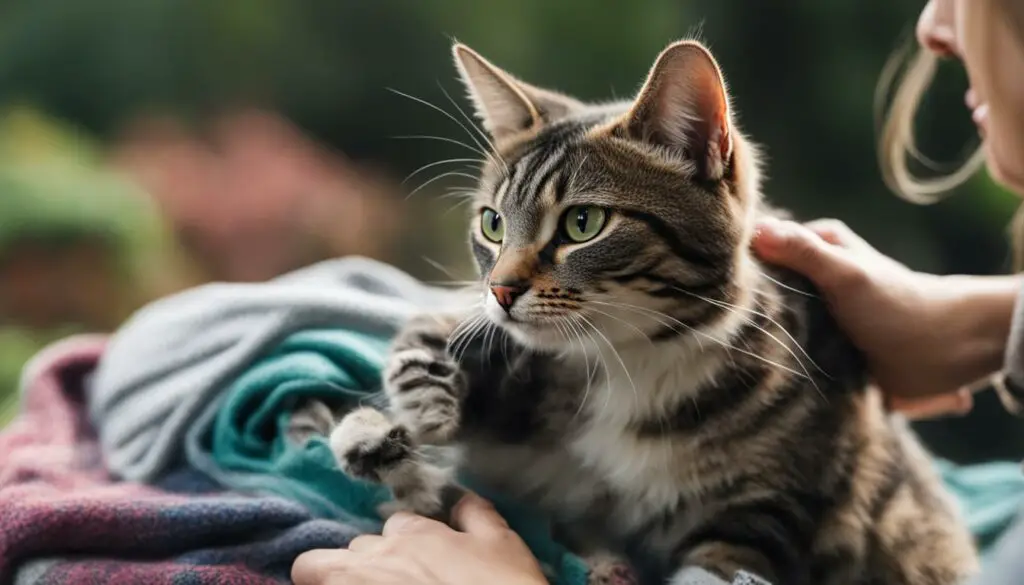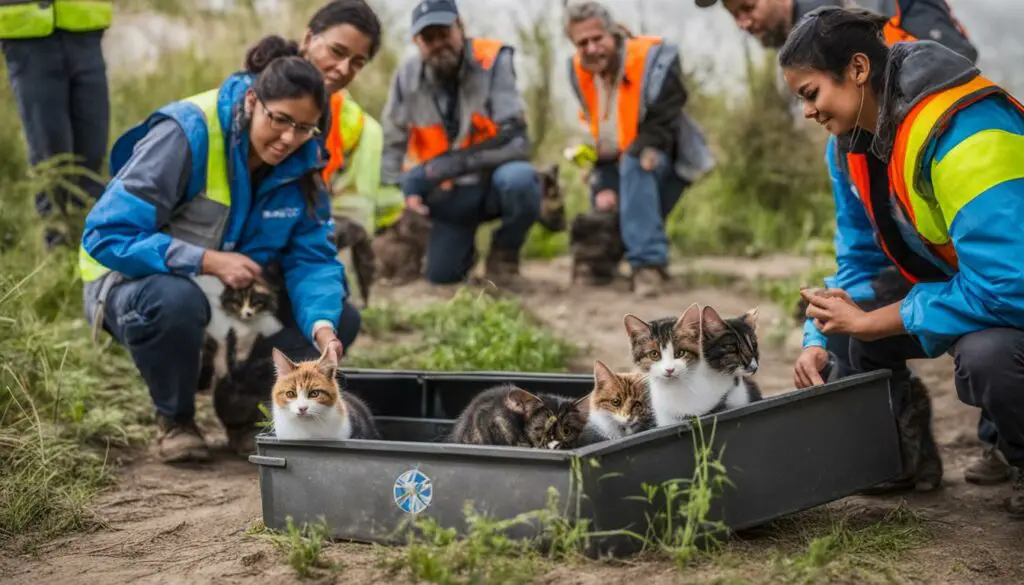When you come across a stray cat, you may wonder if you can keep them as a pet. The answer to this question depends on various factors such as your ability to care for the cat, their behavior, and local laws. In this article, we will explore the considerations and options for keeping a stray cat as a companion.
Key Takeaways:
- Deciding whether to keep a stray cat requires considering your ability to care for them and local laws.
- Transporting a stray cat to safety involves contacting animal shelters or rescue organizations for assistance.
- Finding the owner of a stray cat involves contacting local animal shelters and scanning for a microchip.
- Bringing a stray cat home requires keeping them separate from resident animals and posting notices to locate the owner.
- Understanding local laws is crucial to ensure you are acting within the legal framework when caring for a stray cat.
Transporting a Stray Cat to Safety
When you come across a stray cat that needs help, it’s important to ensure their safety by transporting them to a secure place. Here are some steps to consider:
Gathering Information
Before transporting the stray cat, gather as much information as possible about their behavior and condition. This will be helpful for animal control or rescue organizations to assess the cat’s needs. Take note of any visible injuries, signs of illness, or aggressive behavior.
Contacting Animal Control or Shelters
If you decide not to keep the cat and want to ensure their well-being, contact your local animal control or nearby animal shelters. Inform them about the stray cat and request their assistance. They will be able to guide you on the proper protocols and provide a safe place for the cat.
Reaching Out to Rescue Organizations
In addition to animal control and shelters, consider reaching out to local rescue organizations that specialize in stray cat rescue and adoption. They can provide valuable guidance and support throughout the adoption process if you decide to keep the cat or assist you in finding a suitable home for the cat.

| Transporting a Stray Cat to Safety |
|---|
| Step 1: Gather information about the cat’s behavior and condition |
| Step 2: Contact animal control or local shelters for assistance |
| Step 3: Reach out to rescue organizations for guidance and support |
Finding the Owner of a Stray Cat
If you come across a stray cat and wish to find its owner, there are several steps you can take to increase the chances of a successful reunion.
Firstly, it’s important to contact your local animal shelter or animal control office. They can assist you in reuniting the cat with its owner if the cat has been reported missing. They may have information on recent lost cat reports and can help facilitate the identification process.
In addition, it’s a good idea to have the stray cat scanned for a microchip. Many cats are microchipped for identification purposes, and scanning the cat can provide valuable information about its owner. Microchips contain contact information that can help reunite the cat with its rightful owner.
Lastly, taking pictures of the stray cat and creating “found pet” fliers to distribute in the area can also be effective in finding the owner. Providing a clear description of the cat’s appearance, as well as contact information, can help interested parties get in touch with you if they recognize the cat. Remember to include any distinguishing features or markings that may make the cat easier to identify.

Bringing a Stray Cat Home
Bringing a stray cat into your home can be a rewarding experience, but it’s important to take certain precautions to ensure the safety and well-being of both the stray cat and your resident animals. Before introducing the stray cat to your home, make sure you have a separate space where the cat can stay initially. This will allow the cat to acclimate to their new surroundings and help prevent any potential conflicts with your other pets. Provide the stray cat with food, water, a litter box, and a comfortable place to rest.
When bringing a stray cat home, it’s essential to act with caution, as the cat may be sick, aggressive, or fearful towards other animals. Before interacting with the cat, wash your hands thoroughly to prevent the spread of any potential diseases. Gradually introduce the stray cat to your resident animals, allowing them to interact through a barrier, such as a gate or a door, to assess their reactions. If any aggression or stress is observed, consult with a professional animal behaviorist or veterinarian for guidance.
To increase the chances of locating the owner of the stray cat, take pictures of them and create “found pet” fliers to distribute in the local area. Include a clear description of the cat’s appearance and any unique identifying features. Post notices at veterinary hospitals and on relevant websites to reach a wider audience. Additionally, consider posting on social media platforms and community groups to spread the word about the found cat. By taking these steps, you can help reunite the stray cat with their owner if they are missing.
| H3: Tips for Bringing a Stray Cat Home |
|---|
| 1. Provide a separate space for the stray cat initially to help them acclimate to their new environment. |
| 2. Introduce the stray cat to your resident animals gradually, using a barrier to assess their reactions. |
| 3. Wash your hands thoroughly before and after interacting with the stray cat to prevent the spread of diseases. |
| 4. Take pictures of the stray cat and create “found pet” fliers to distribute in the local area. |
| 5. Post notices at veterinary hospitals, on relevant websites, and on social media platforms to increase the chances of reuniting the cat with their owner. |
Understanding Local Laws Regarding Stray Cats
If you are considering keeping a stray cat, it’s important to familiarize yourself with the local laws and regulations in your area. Each state, county, or town may have different rules regarding the ownership and care of stray cats. Contacting your local animal control agency, humane society, or SPCA can provide you with valuable information about legal obligations and processes involved in caring for a stray cat.

By understanding the local laws, you can ensure that you are acting within the legal framework and taking the necessary steps to provide proper care for the stray cat. It’s important to note that in some areas, there may be restrictions on the number of animals you can keep, licensing requirements, or specific guidelines for outdoor cats. Violating these laws can result in fines or other legal consequences.
Table: Overview of Local Laws Regarding Stray Cats
| Local Jurisdiction | Ownership Regulations | Licensing Requirements | Outdoor Cat Guidelines |
|---|---|---|---|
| State A | Allowed with registration | Yes | Must be kept indoors or in an enclosed outdoor space |
| County B | Allowed with no restrictions | No | No specific guidelines |
| Town C | Not allowed | N/A | N/A |
In addition to understanding the legal aspects, it’s important to consider the welfare of the stray cat. Taking into account your ability to provide proper care, such as food, shelter, and veterinary attention, is crucial. Remember that stray cats may have specific needs or behavioral issues that require patience and understanding.
By being aware of the local laws and being prepared to meet the needs of a stray cat, you can make an informed decision about whether to keep them as a companion and ensure that you are providing a safe and nurturing environment.
The Role of Shelters and Rescue Agencies
Shelters and rescue agencies are essential in the effort to care for stray cats. These organizations provide a safe haven for homeless cats and work tirelessly to find them permanent homes. However, it’s important to understand that shelters and rescue agencies often have limitations when it comes to resources and space. This means that they may not be able to provide extensive care, especially for injured or sick stray cats.
Despite these limitations, shelters and rescue agencies play a vital role in the overall welfare of stray cats. They provide necessary medical care, vaccinations, and spay/neuter services to ensure the health and well-being of the cats in their care. They also work diligently to match stray cats with potential adopters, helping to find them loving and permanent homes.
The Importance of Support
While shelters and rescue agencies do incredible work, they rely heavily on support from the community. Donations, volunteer work, and foster homes are all crucial in enabling these organizations to continue their efforts. By supporting local shelters and rescue agencies, you are directly contributing to the welfare of stray cats and helping to improve their lives.

Overall, the role of shelters and rescue agencies in the care of stray cats cannot be understated. Despite the challenges they face, they continue to work tirelessly to provide a safe haven for these vulnerable animals and help them find their forever homes. By supporting these organizations, you can make a meaningful difference in the lives of stray cats and contribute to their overall well-being.
Section 7: Seeking Veterinary Care for a Stray Cat
If you come across an injured stray cat and decide to take them to a veterinary hospital, be prepared to take financial responsibility for their treatment. Veterinary care can be expensive, and many veterinarians have limited resources available for treating stray animals. It’s essential to discuss the financial aspects with the veterinarian before proceeding with any medical interventions. This will ensure that you are fully prepared and can make informed decisions regarding the cat’s healthcare needs.
Remember that when seeking veterinary care for a stray cat, it’s important to provide as much information as possible about the cat’s behavior and any visible injuries. This will help the veterinarian assess the cat’s condition and determine the appropriate course of treatment. It’s also crucial to inform the veterinary staff that the cat is a stray, as this may impact their protocols for handling and isolating the cat to prevent the spread of diseases.
If you’re unable to cover the cost of veterinary care for a stray cat, consider reaching out to local rescue organizations or animal welfare groups for assistance. They may have programs or resources available to help cover the costs of medical treatment. Additionally, some veterinary hospitals offer discounted services or payment plans for stray animals in need.

Quoting a Veterinary Expert:
“When it comes to providing veterinary care for stray cats, it’s important to consider the financial aspect. Stray cats often require a range of medical treatments, from vaccinations to surgeries, and these can be costly. It’s crucial to have open and transparent communication with your veterinarian about the financial obligations involved. This will help ensure that you can provide the necessary care for the stray cat without compromising your own financial wellbeing.”
| Veterinary Care Options for Stray Cats | Pros | Cons |
|---|---|---|
| Seeking treatment at a veterinary hospital | – Access to professional medical expertise – Comprehensive care options – Potential for long-term medical support |
– Financial responsibility – Limited resources for stray animals – Potentially limited availability for emergency cases |
| Seeking assistance from rescue organizations | – Potential financial assistance – Access to specialized resources – Networking with experienced caregivers |
– Reliance on available resources – Time-consuming application processes – Limited availability of funding |
| Exploring discounted services or payment plans | – Potential financial relief – Expanded options for care – Flexible payment options |
– Availability varies by veterinary hospital – May not cover all required treatments – Potential long-term financial commitments |
Seeking veterinary care for a stray cat is an act of compassion and responsibility. It’s crucial to ensure that the cat receives the necessary medical attention to alleviate any pain or suffering. By considering the financial aspects, communicating with veterinary professionals, and exploring available resources, you can make a difference in the life of a stray cat and contribute to their overall well-being.
Considering Long-Term Care for a Stray Cat
If you have made the decision to bring a stray cat into your life but are unable to provide long-term care, there are options available to ensure the cat finds a loving and permanent home. One option is to reach out to local rescue organizations or animal shelters that have adoption programs. These organizations have the necessary resources and experience to help find a suitable home for the cat. They will work to identify potential adopters and facilitate the adoption process.
When contacting rescue organizations or shelters, it’s important to provide them with as much information as possible about the cat, including their behavior, medical history, and any specific needs they may have. This will help the organization match the cat with the right adoptive family. Additionally, you may be required to fill out an adoption application and pay an adoption fee to cover any costs associated with the cat’s care while at the organization.
It’s essential to assess your own capabilities and commitments before taking on the responsibility of long-term care for a stray cat. While these cats can bring joy and companionship, they also require time, attention, and resources. If you are uncertain about your ability to provide the necessary care, it’s best to work with a rescue organization or shelter that can ensure the cat’s welfare and find them a suitable forever home.
| Benefits of Re-Homing a Stray Cat | Considerations for Re-Homing a Stray Cat |
|---|---|
|
|

“Choosing to re-home a stray cat is a responsible and compassionate decision. By working with a reputable rescue organization or shelter, you can ensure that the cat finds a forever home where they will receive the love and care they deserve.” – Anonymous
Understanding Community Cats
Community cats, also known as stray cats, are domestic cats that live outdoors and do not have an owner. These cats can exhibit a range of behaviors, from being fearful and wary of people to being friendly and open to human interaction. They are often found near areas where people live or work and rely on humans for support in terms of food, shelter, and medical care.
When considering whether to keep a stray cat as a companion, it’s important to understand their unique needs. Some community cats may have been born outdoors and have adapted to this lifestyle, while others may have been lost or abandoned. Their behavior can vary based on their experiences, and it’s crucial to approach each cat with patience, understanding, and respect.
It’s worth noting that community cats play an important role in managing rodent populations and can provide companionship to individuals who appreciate their presence. However, it’s essential to ensure that their welfare is prioritized by providing them with appropriate food, water, and shelter, as well as spaying or neutering to control their population.

Overall, understanding community cats and their behaviors is essential for anyone considering keeping a stray cat as a companion. By providing the necessary care and support, we can make a positive impact on the lives of these cats and contribute to their overall welfare.
Why There Are Many Cats Outdoors
Outdoor cats have become a common sight in many communities, with estimates suggesting that there are around 30 to 40 million community cats in the United States alone. The reasons for the high population of outdoor cats can be attributed to several factors.
One of the main reasons for the abundance of outdoor cats is the lack of effective spay/neuter programs. Without these programs, cats can reproduce rapidly, leading to an increase in the number of stray and feral cats. In addition, some outdoor cats may have been lost or abandoned by their owners and have adapted to life on the streets.
“The lack of effective spay/neuter programs and the abandonment of cats contribute to the growing population of outdoor cats.”
Another factor contributing to the high number of outdoor cats is the presence of food sources in residential areas. Garbage bins, outdoor pet food left unattended, and even the kindness of individuals feeding stray cats can attract and sustain these feline populations. With a reliable food source, outdoor cats can survive and reproduce more successfully.
| Factors Leading to the High Population of Outdoor Cats |
|---|
| Lack of effective spay/neuter programs |
| Lost or abandoned cats adapting to life on the streets |
| Presence of food sources in residential areas |
To address the issue of high outdoor cat populations, it is crucial to implement comprehensive spay/neuter initiatives that target both owned and unowned cats. By sterilizing cats and preventing their reproduction, we can help control the population and reduce the number of cats living outdoors.

Stray Cat Behavior: The Impact of Outdoor Life
Living outdoors can have a significant impact on a cat’s behavior. Stray cats may exhibit behaviors such as territorial marking, hunting, and vocalization as they navigate their outdoor environment. These behaviors are often a result of their need to survive and establish their territory.
Stray cats may also be more cautious and elusive around humans, as they have learned to be wary of potential threats. However, it’s important to note that not all outdoor cats exhibit the same behavior. Some may be more friendly and receptive to human interaction, especially if they have been socialized or have had positive experiences with people in the past.
- Stray cats may exhibit territorial marking and hunting behavior
- They may be cautious and elusive around humans
- Not all outdoor cats exhibit the same behavior
Understanding the behavior of outdoor cats is essential when considering whether to keep a stray cat as a companion. It’s important to assess their individual temperament and needs to determine if they will adapt well to an indoor environment and be comfortable living with humans.
The Benefits of Trap-Neuter-Return (TNR)
When it comes to managing the population of community cats, Trap-Neuter-Return (TNR) programs offer numerous benefits. By humanely trapping cats, sterilizing them, vaccinating them, and then returning them to their outdoor homes, TNR programs help to reduce cat populations and minimize mating-related behaviors. This approach has been shown to improve the overall well-being of community cats and create healthier, more stable feline colonies.
TNR programs are effective in addressing the issue of overpopulation in outdoor cats. By sterilizing cats, these programs prevent the birth of countless kittens and new litters, helping to slow down population growth. This is especially important considering that community cats can reproduce rapidly, leading to exponential increases in their numbers if left unchecked.
Another benefit of TNR is the reduction in mating-related behaviors. Unaltered cats exhibit behaviors such as yowling, fighting, and spraying to attract mates. By spaying and neutering cats through TNR, these mating behaviors are significantly reduced, resulting in a more peaceful and harmonious environment for both the cats and the surrounding community.
TNR programs also contribute to the overall health and well-being of community cats. Through these programs, cats are provided with necessary veterinary care, including vaccinations against diseases. This not only protects the cats themselves but also helps prevent the spread of diseases to other animals, including pets and wildlife. By ensuring that community cats are healthy, TNR programs promote a healthier ecosystem and reduce the potential for disease transmission.

The Benefits of Trap-Neuter-Return (TNR)
| BENEFITS OF TNR | DESCRIPTION |
|---|---|
| Population control | TNR programs help reduce the population of community cats by preventing the birth of new litters. |
| Minimizes mating-related behaviors | Spaying and neutering cats through TNR reduces yowling, fighting, and spraying behaviors associated with mating. |
| Improved overall well-being | TNR programs provide necessary veterinary care, including vaccinations, to ensure the health of community cats. |
| Prevents disease transmission | By vaccinating community cats, TNR programs help prevent the spread of diseases to other animals. |
Addressing Concerns About Outdoor Cats
When it comes to outdoor cats, there are often concerns about their behaviors and impact on the environment. However, it’s important to recognize that there are effective strategies in place to address these concerns and promote the well-being of outdoor cats.
Trap-Neuter-Return (TNR) programs have proven to be a valuable tool in managing the population of community cats. By sterilizing and vaccinating these cats, TNR programs help reduce mating-related behaviors and the risk of certain diseases. This approach also ensures that cats are returned to their outdoor homes, where they can continue to provide natural pest control.
Furthermore, it’s essential to consider the overall health of outdoor cats. Studies have shown that community cats are generally fit and healthy, with low rates of suffering. After being sterilized and vaccinated, these cats have greater immunity against diseases, fight less, and stay closer to their homes, reducing the risk of injuries or accidents.
By understanding the impact of TNR programs and the benefits they provide, concerns about outdoor cats can be mitigated. These programs not only help manage the cat population but also contribute to the overall welfare of community cats and the communities they inhabit.

| Concerns about Outdoor Cats | Addressing Strategies |
|---|---|
| Digging, urinating, and defecating in yards | Implementing TNR programs to reduce the cat population and minimize mating-related behaviors |
| Jumping on cars | Spaying and neutering cats to reduce the risk of certain diseases and control their behavior |
| Preying on wildlife | Providing natural pest control in outdoor environments |
It’s important to address concerns about outdoor cats through education and awareness. By sharing the benefits of TNR programs and the positive impact that community cats can have, we can foster a more compassionate understanding of these animals and their role in our communities.
The Safety of Outdoor Cats
When considering whether to keep a stray cat as a companion, it’s important to understand the safety of outdoor cats. While there are risks associated with outdoor life, studies have shown that community cats are generally fit and healthy with a low rate of suffering. After being sterilized and vaccinated, these cats have greater immunity against diseases, fight less, and stay closer to their homes, reducing the risk of injuries or accidents.
It’s important to consider the overall well-being of outdoor cats and make informed decisions about their care based on evidence and expert guidance. By providing them with regular access to food, water, and shelter, as well as monitoring their behavior and ensuring they have a safe environment, you can help ensure their safety and well-being.

While outdoor cats may face certain challenges, it’s important to remember that they are resilient and adaptable animals. With proper care and attention, outdoor cats can lead healthy and fulfilling lives. However, it’s always recommended to consult with local rescue organizations or animal welfare agencies for specific guidance on how to best care for outdoor cats in your area.
The Role of Shelters and Rescue Groups for Community Cats
Shelters and rescue groups play a crucial role in supporting community cats. They are dedicated to implementing Trap-Neuter-Return (TNR) programs, providing veterinary care, and offering guidance to caregivers. These organizations understand the unique needs of community cats and are committed to their welfare. By working together, we can make a significant impact on the lives of these cats and create a more compassionate community.
Shelters and rescue groups actively participate in reducing the population of community cats through spaying and neutering initiatives. They understand that sterilization is essential to prevent the overpopulation of outdoor cats, minimize mating-related behaviors, and improve the overall health of these cats. These organizations play a vital role in ensuring that community cats receive the necessary veterinary care, such as vaccinations and medical treatments, to enhance their well-being.
“Shelters and rescue groups actively participate in reducing the population of community cats through spaying and neutering initiatives.”
In addition to TNR programs, shelters and rescue groups may also provide foster homes to socialize kittens born to community cats. Socialization increases their chances of being adopted into permanent homes, ensuring a brighter future for these kittens. These organizations understand that every cat deserves a loving, safe, and permanent home, and they work tirelessly to find suitable placements for these feline companions.
| Role of Shelters and Rescue Groups for Community Cats |
|---|
| – Implementing Trap-Neuter-Return (TNR) programs |
| – Providing veterinary care and vaccinations |
| – Offering guidance and support to caregivers |
| – Providing foster homes to socialize kittens |
| – Facilitating adoptions into permanent homes |

By supporting shelters and rescue groups, whether through volunteering, donations, or adopting a cat, you can make a difference in the lives of community cats. Together, we can create a safer and more compassionate environment for these cats, ensuring they receive the care and love they truly deserve.
Conclusion
After considering the various factors involved in keeping a stray cat, it’s clear that there are options available for providing care and support to these animals. Can you keep a stray cat? The answer is yes, but it’s essential to be prepared for the responsibilities that come with it. Stray cat care requires attention to their behavior, understanding of local laws, and the ability to meet their unique needs.
Adopting a stray cat can be a rewarding experience, but it’s important to assess your own capabilities and commitments before making the decision. If you are unable to keep the cat long-term, re-homing through local rescue organizations or animal shelters is a viable option. These organizations can help find a loving and permanent home for the cat, ensuring their well-being for years to come.
Additionally, supporting Trap-Neuter-Return (TNR) programs can contribute to addressing the issue of outdoor cat populations. By implementing TNR initiatives, communities can help manage the population of community cats and improve their overall welfare. Shelters and rescue groups play a crucial role in assisting with these programs, providing veterinary care, and offering guidance to caregivers.
In conclusion, whether you decide to keep a stray cat, re-home them, or support TNR initiatives, your actions can make a positive impact on the lives of these animals. By providing stray cat care, you are not only ensuring their well-being but also contributing to the betterment of the community. So, can you keep a stray cat? The choice is yours, and it’s an opportunity to provide a loving home for a cat in need.
FAQ
Can I keep a stray cat as a pet?
Whether or not you can keep a stray cat as a pet depends on your ability to care for the cat, their behavior, and local laws.
What should I do if I find a stray cat?
If you find a stray cat and are able to transport them, it’s important to take them to a safe place. You can contact your nearest animal shelter or animal control for assistance.
How can I find the owner of a stray cat?
To find the owner of a stray cat, you can contact your local animal shelter or animal control office. They can help reunite the cat with its owner if they have been reported missing.
What should I do before bringing a stray cat home?
Before bringing a stray cat into your home, it’s important to ensure you can keep them separate from your resident animals. This is because the stray cat may have health or behavioral issues.
What are the legal considerations for keeping a stray cat?
It’s crucial to check the laws in your state, county, or town regarding stray cats. Each jurisdiction may have different regulations and requirements for individuals who find stray cats.
How do shelters and rescue agencies help stray cats?
Shelters and rescue agencies provide a safe and supportive environment for homeless cats and work towards finding them permanent homes. They also assist in implementing TNR programs and offering guidance to caregivers.
What should I do if I find an injured stray cat?
If you find an injured stray cat and decide to take them to a veterinary hospital, be prepared to take financial responsibility for their treatment. Veterinary care for stray animals can be expensive.
What should I do if I can’t keep a stray cat long-term?
If you are unable to keep a stray cat long-term, you can reach out to local rescue organizations or animal shelters to inquire about their adoption programs. They may be able to help find a permanent home for the cat.
What are community cats?
Community cats are outdoor domestic cats that have no indication of having an owner. They rely on humans for support, such as providing food, shelter, and medical care.
Why are there so many cats outdoors?
The outdoor cat population is a concern due to inadequate spay/neuter programs. Without proper intervention, these cats continue to reproduce, contributing to the growing population of outdoor cats.
What are the benefits of Trap-Neuter-Return (TNR)?
Trap-Neuter-Return (TNR) is a nonlethal strategy for managing the population of community cats. It helps reduce the cat population, minimize mating-related behaviors, and improve the overall well-being of community cats.
How can concerns about outdoor cats be addressed?
Trap-Neuter-Return (TNR) programs can help address concerns about outdoor cats by reducing the cat population and minimizing mating-related behaviors. Spaying and neutering cats also reduces the risk of certain diseases.
Are outdoor cats safe?
Studies have shown that community cats are generally fit and healthy with a low rate of suffering. After being sterilized and vaccinated, these cats have greater immunity against diseases and stay closer to their homes, reducing the risk of injuries or accidents.
What is the role of shelters and rescue groups for community cats?
Shelters and rescue groups play a crucial role in supporting community cats. They provide veterinary care, implement TNR programs, and offer guidance to caregivers. They also may provide foster homes to socialize kittens born to community cats.








